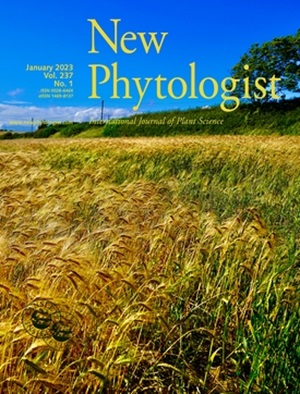Metamorphosis of a unicellular green alga in the presence of acetate and a spatially structured three-dimensional environment
IF 8.3
1区 生物学
Q1 PLANT SCIENCES
引用次数: 0
Abstract

单细胞绿藻在醋酸盐和三维空间结构环境下的蜕变过程
微藻是微小的真核光合生物,生活在海洋、淡水、土壤甚至冰中。它们代表了一个具有不同进化起源的多物种群体,并参与了许多具有巨大生态重要性的过程。微藻与原核生物蓝绿藻(蓝藻)一起贡献了全球约一半的碳固定(Field et al., 1998;Brodie等人,2017)。在过去的几十年里,已经对几种藻类基因组进行了测序,导致了遗传上可处理的微藻模型的发展(Grossman, 2007;Brodie et al., 2017;Falciatore et al., 2020)。最早发育良好的藻类模型之一是绿色微藻莱茵衣藻(Chlamydomonas reinhardtii),它最初是从美国的一块马铃薯田分离出来的(Harris, 1989)。在其自然栖息地,它通常存在于潮湿的土壤中,与其他微生物共存(Sasso et al., 2018)。然而,在实验室环境中,它通常在液体培养中进行无菌培养。biciliate C. reinhardtii细胞有一个杯状的叶绿体,在靠近细胞赤道的边缘有一个原始的视觉系统,称为眼斑。在叶绿体内,也有含有RuBisCO的类pyrenoid,并被淀粉片包围(Harris, 1989;Sasso et al., 2018)。莱茵衣藻通过有丝分裂以单倍体营养细胞的形式进行无性繁殖,其交配型为正或负。在不利的环境条件下(缺乏氮源),C. reinhardtii启动有性生命周期,允许有性杂交(Sasso et al., 2018)。莱茵衣藻(Chlamydomonas reinhardtii)是研究不同生物过程的模型,如光合作用及其驯化、纤毛或光驱动过程的功能、生物发生和长度(Grossman, 2000;Petersen et al., 2022;Sakato-Antoku,王,2022;Ishikawa et al., 2023)。莱茵哈蒂杆菌的基因组已经测序(Merchant et al., 2007),最近发布了一种野生型菌株的新版本(Craig et al., 2023)。此外,许多分子工具可用于这种藻类以及大规模突变文库(Li et al., 2019;Schroda, 2019;Fauser et al., 2022)。尽管在实验室环境中对易于快速培养的模型藻类有迫切的需求,但我们必须意识到,实验室的生长条件并不能反映它们主要的自然栖息地。有些藻类,如莱茵水藻,生活在土壤中,这是一个高度复杂的栖息地。包括微生物在内的土壤生物的广泛生物多样性最近得到强调,估计地球上甚至有59%的物种生活在土壤中(Anthony et al., 2023)。莱茵衣藻通常与影响其适应性的其他微生物共存,例如通过分泌维生素B12或毒素,如环脂肽orfamide A或聚酰胺protegencin (Hotter et al., 2021;Bunbury et al., 2022;侯等人,2023)。捕食、养分供应和水湍流甚至被证明可以塑造从单细胞绿藻到多细胞绿藻的转变(Cornwallis et al., 2023)。在这里,我们用莱茵梭菌作为模型,离土壤微藻的自然环境又近了一步。衣单胞菌属,包括莱茵衣单胞菌,在稻田土壤中经常被发现(Barrett &;科赫,1982;Ghasemi et al., 2008;Lin等人,2013)以及淘米水(Szydlowski等人,2019;Carrasco Flores等人,2024)。因此,我们以莱茵冷杉的自然栖息地水稻土为例。我们在含有醋酸盐的培养基中培养藻类,醋酸盐是水稻土壤中最丰富的有机碳中间体,在光-暗循环中(Hori et al., 2007;沈等人,2014)。莱茵衣藻(Chlamydomonas reinhardtii)可以利用醋酸盐作为碳源,在有光的情况下进行混养生长(Harris, 1989)。此外,我们还引入了一个具有空间结构的三维组件(S3-D;图1a)模拟沙质水稻土(Chinachanta et al., 2020)。RNA-Seq数据显示S3-D中强烈的转录重编程与形态学和分子水平的变化一致。此外,多微生物的相互作用也发生了变化。绿色微藻莱茵衣藻(Chlamydomonas reinhardtii)在空间结构的三维环境(S3-D)中生长增强,其转录组在乙酸存在下S3-D发生重大变化。(a)用于微藻细胞在s3d中生长的装置(详见材料和方法部分)。(b - e)将藻类生长在铺有不同大小玻璃珠(+GB)的注射器管中或纯液体培养(−GB,见(b)中的绿色箭头)中。不同的颜色表示纯液体培养或S3-D培养,如所示,大小珠子的比例不同。C.照片;
本文章由计算机程序翻译,如有差异,请以英文原文为准。
求助全文
约1分钟内获得全文
求助全文
来源期刊

New Phytologist
生物-植物科学
自引率
5.30%
发文量
728
期刊介绍:
New Phytologist is an international electronic journal published 24 times a year. It is owned by the New Phytologist Foundation, a non-profit-making charitable organization dedicated to promoting plant science. The journal publishes excellent, novel, rigorous, and timely research and scholarship in plant science and its applications. The articles cover topics in five sections: Physiology & Development, Environment, Interaction, Evolution, and Transformative Plant Biotechnology. These sections encompass intracellular processes, global environmental change, and encourage cross-disciplinary approaches. The journal recognizes the use of techniques from molecular and cell biology, functional genomics, modeling, and system-based approaches in plant science. Abstracting and Indexing Information for New Phytologist includes Academic Search, AgBiotech News & Information, Agroforestry Abstracts, Biochemistry & Biophysics Citation Index, Botanical Pesticides, CAB Abstracts®, Environment Index, Global Health, and Plant Breeding Abstracts, and others.
 求助内容:
求助内容: 应助结果提醒方式:
应助结果提醒方式:


